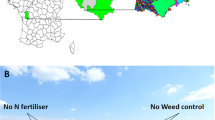Abstract
Management of crop—fallow rotations should strike a balance between exploitation, during cropping, and restoration of soil fertility during the fallow period. The ‘Trenbath’ model describes build-up of soil fertility during a fallow period by two parameters (a maximum level and a half-recovery time) and decline during cropping as a simple proportion. The model can be used to predict potential crop production for a large number of management options consisting of length of cropping period and duration of fallow. In solving the equations, the model can be restricted to ‘sustainable’ systems, where fallow length is sufficient to restore soil fertility to its value at the start of the previous cropping period. The model outcome suggests that the highest yields per unit of land can be obtained by starting a new cropping period after soil fertility has recovered to 50–60% of its maximum value. This prediction is virtually independent of the growth rate of the fallow vegetation. The nature of the fallow vegetation (natural regrowth, planted trees, or cover crops) mainly influences the crop yield by modifying the required duration of fallow periods. Intensification of land use by shortening fallow periods will initially increase returns per unit land at the likely costs of returns per unit labor. When fallows no longer restore soil fertility to 50% of the maximum, overall productivity will decline both per unit land and per unit labor, unless external inputs replace the soil fertility restoring functions of a fallow.
Similar content being viewed by others
References
Cairns MC and Garrity DP (1999) Improving shifting cultivation in Southeast Asia by building on indigenous fallow management strategies. Agroforestry Systems (this issue)
Gouyon A, De Foresta H and Levang P (1993) Does ‘jungle rubber’ deserve its name? An analysis of rubber agroforestry systems in southeast Sumatra. Agroforestry Systems 22: 181–206
Mobbs DC and MGR Cannell (1995) Optimal tree fallow rotations: some principles revealed by modeling. Agroforestry Systems 29: 113–132
Nye PH and Greenland DJ (1960) The Soil under Shifting Cultivation. Commonwealth Agricultural Bureaux, Harpenden, England
Parton WJ, McKeown BMC, Kirchner V and Ojima D (1992) Century Users's Manual. Colorado State University, Fort Collins, CO, USA
Robertson WH (1994) Modeling soil nitrogen levels under acacia/sorghum rotations. Agroforestry Systems 27: 283–293
Ruthenberg H (1976) Farming Systems in the Tropics. Second edition. Oxford University Press, Oxford, UK, 366 pp
Sanchez PA (1995) Science in agroforestry. Agroforestry Systems 30: 5–55
Trenbath BR (1984) Decline of soil fertility and the collapse of shifting cultivation systems under intensification. Chadwick AC and Sutton SL (eds) Tropical Rain-Forest: the Leeds Symposium, pp 279–292. Leeds Philosophical and Literary Society, Leeds, UK
Trenbath BR (1989) The use of mathematical models in the development of shifting cultivation. In: Proctor J (ed) Mineral Nutrients in Tropical Forest and Savanna Ecosystems, pp 353–369. Blackwell, Oxford, UK
Van Noordwijk M, Hairiah K, Guritno B, Sugito Y and Ismunandar S (1996a) Biological management of soil fertility for sustainable agriculture on acid upland soils in Lampung (Sumatra). AGRIVITA 19: 131–136
Van Noordwijk M, Lawson G, Groot JJR, Hairiah K (1996b) Root distribution in relation to nutrients and competition. In: Ong CK and Huxley PA (eds) Tree-Crop Interactions — a Physiological Approach, pp 319–364. CAB International, Wallingford, UK
Van Noordwijk M, Hairiah K, Partoharjono S, Labios RV and Garrity DP (1997) Sustainable food-crop based production systems, as alternative to Imperata grasslands? Agroforestry Systems 36: 55–58
Author information
Authors and Affiliations
Rights and permissions
About this article
Cite this article
van Noordwijk, M. Productivity of intensified crop—fallow rotations in the Trenbath model. Agroforestry Systems 47, 223–237 (1999). https://doi.org/10.1023/A:1006223715411
Issue Date:
DOI: https://doi.org/10.1023/A:1006223715411




